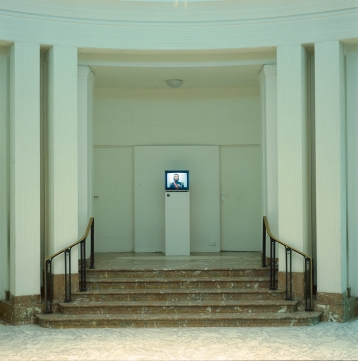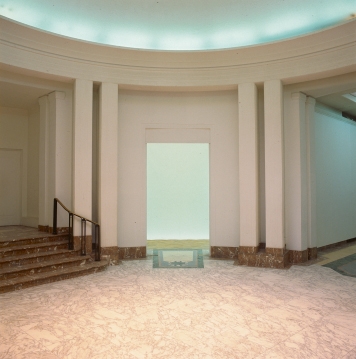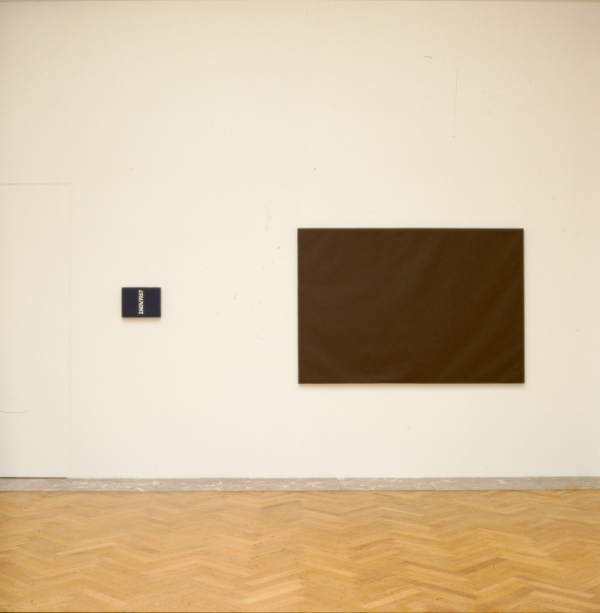
Installation view, rotunda, Palais de Beaux-Arts, Brussels, 1992
Installation view, room 1, Palais de Beaux-Arts, Brussels, 1992
Installation view, room 2, Palais de Beaux-Arts, Brussels, 1992
"Two Important Dates in My Life," 1991
Fixed Values
14 December 1991 – 19 January 1992
Palais des Beaux-Arts, Brussels
Rotunda:
– “The King’s Welcoming Speech,” 1988, monitor with video on base, 3 min.; Sammlung Karola Grässlin
Room 1:
– Vitrine, 1991, wooden display case, objects from performance labeled with their auction number (photo originals from Germany, German peaked cap, entry tickets, men’s shoes, roll of wall paper on top of a page with a Rémy Martin ad, clover, “Le poème électronique” by Le Corbusier, drawing “Progressive Stimulierungskurve,” tape recorder, color photograph with cover, box with glued-on piece of newspaper); Collection Bruno van Lierde, Brussels
Room 2:
– “Sich vordrängender Hintergrund,” 1991, paper, mechanism for hanging, rolled-up length variable; 143 x 1181 inches; courtesy of Galerie Christian Nagel, Cologne / Berlin
– “Two Important Dates in My Life,” 1991, acrylic on canvas, two parts 10 x 13 inches / 61 x 76 inches; Daled Collection, Brussels
Room 3:
– Installation: fabric wall covering, 16 halogen spotlights, felt and signs with auction numbers
– “Köln–Düsseldorf,” 1990, 16 Plexiglas cubes, disassembled, varying dimensions; Sammlung Karola Grässlin
In “Fixed Values,” only six years after his public debut, Christian Philipp Müller undertook a complete self-historicization: a solo exhibition in the guise of a museum auction of his own artistic history. In four rooms in the east wing of the Palais des Beaux-Arts in Brussels, he presented props and objects from his previous works: admission tickets from the Düsseldorf-Hellerhof performances, clover leaves from “Porte bonheur,” the video “The King’s Welcoming Speech,” from the Antwerp artists’ club Arti et Amicitiae, and Plexiglas cubes from the “Köln–Düsseldorf” exhibition at Galerie Nagel. Müller’s work generally consists of contexts rather than mere objects; here, that fact resulted, conversely, in an exhibition of references, both to Müller’s own history and to that of the Palais des Beaux-Arts. Constructed by Victor Horta and beginning in 1922, the gigantic museum complex is set in a mountainside and houses three concert halls, numerous exhibition and meeting spaces, an auction house, a theater, and a cinema as well as bars and restaurants.
In “Fixed Values,” both the presentation of the objects and the layout of the exhibition catalogue were inspired by the auction house annexed to the museum. The auction house was located in the north wing of the building; the path to its entrance led through Müller’s exhibition in the Antichambre. The auctions that took place there provided a source of income for the museum, with items sold ranging from furniture to paintings. In the auction catalogues, this indiscriminate mass of cultural goods was divided up into such categories as jewelry, sculpture, painting, furniture, glass, and silverware, with estimated prices provided for each object. Müller’s exhibition catalogue was identical to the auction catalogues in layout, paper, and color. His objects, not produced for this exhibition, but pre-existing, were listed and classified as video, vitrine or decorative objects. They were numbered consecutively, and assigned an estimated value. As in the auction catalogues, the pieces were praised for their rarity and fine materials, and visitors could use the numbering of the artifacts in the catalogue as a guide to the exhibition.
Müller’s catalogue was displayed in the entrance rotunda, where his previous artist’s books from 1984 to 1991 were also arranged in vitrines. In accord with the numbering in the catalogue, visitors encountered “The King’s Welcoming Speech” while still in the round entrance foyer; passing to the right into a virtually empty, dimly lit room, they saw a spotlighted vitrine with artifacts from the preceding performances. To the left of the “King” was a second large room, hidden behind a strip of white paper hanging from ceiling to floor, a device for neutralizing space photographers often use. Behind it, visitors encountered two new objects, oil paintings produced by Müller in homage to On Kawara. The smaller of the two, with the text “2.Nov.1957” in white on a dark blue background, was a cover piece for the Belgian art magazine Forum International. The date is Müller’s own birthdate. Corresponding to it was vitrine object number 11, a cardboard box lined on the interior with the cover of the Bieler Tagblatt from November 2, 1957. It was the box for the date painting, its size matching the smallest format used by On Kawara for his date paintings, though rotated to a vertical format. The measurements of the much larger, monochromatic, dark-brown canvas also matched one of On Kawara’s formats, in this case his largest size, which he rarely used and only for important occasions. To this day, Müller’s canvas has not been inscribed; the owner of the two-part work, “Two Important Dates in My Life” (1991), is obligated to enter Müller’s date of death on the painting. A third exhibition space also opened off the entrance rotunda, through which visitors could pass to reach the auction house as well as the simultaneous exhibition “Triumph of Baroque.” The display of jewels in the latter exhibition was echoed in Müller’s presentation of his objects under dramatic lighting. Here, as in the first room, the lighting was done exclusively by spotlight, while the fifteen Plexiglas boxes from the exhibition “Köln–Düsseldorf” (1990) were dismantled into individual pieces, positioned on felt, and displayed.
In each room, the objects were presented in varitions reminiscent of sales displays. In so doing, Müller established a connection not only to the adjacent auction house, but also to the practice of an artist crucial to his own relationship to the city of Brussels: Marcel Broodthaers.
Essay by Miwon Kwon available here.
Essay by George Baker available here.
Review by Judith Welter available here.


